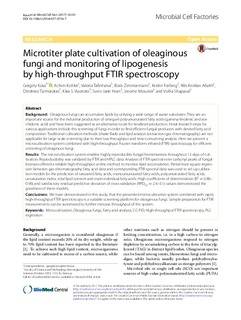| dc.contributor.author | Kosa, Gergely | |
| dc.contributor.author | Kohler, Achim | |
| dc.contributor.author | Tafintseva, Valeria | |
| dc.contributor.author | Zimmermann, Boris | |
| dc.contributor.author | Forfang, Kristin | |
| dc.contributor.author | Afseth, Nils Kristian | |
| dc.contributor.author | Tzimorotas, Dimitrios | |
| dc.contributor.author | Vuoristo, Kiira | |
| dc.contributor.author | Horn, Svein Jarle | |
| dc.contributor.author | Mounier, Jerome | |
| dc.contributor.author | Shapaval, Volha | |
| dc.date.accessioned | 2018-06-26T07:57:14Z | |
| dc.date.available | 2018-06-26T07:57:14Z | |
| dc.date.created | 2017-12-31T19:51:34Z | |
| dc.date.issued | 2017 | |
| dc.identifier.issn | 1475-2859 | |
| dc.identifier.uri | http://hdl.handle.net/11250/2502929 | |
| dc.description.abstract | Background Oleaginous fungi can accumulate lipids by utilizing a wide range of waste substrates. They are an important source for the industrial production of omega-6 polyunsaturated fatty acids (gamma-linolenic and arachidonic acid) and have been suggested as an alternative route for biodiesel production. Initial research steps for various applications include the screening of fungi in order to find efficient fungal producers with desired fatty acid composition. Traditional cultivation methods (shake flask) and lipid analysis (extraction-gas chromatography) are not applicable for large-scale screening due to their low throughput and time-consuming analysis. Here we present a microcultivation system combined with high-throughput Fourier transform infrared (FTIR) spectroscopy for efficient screening of oleaginous fungi. Results The microcultivation system enables highly reproducible fungal fermentations throughout 12 days of cultivation. Reproducibility was validated by FTIR and HPLC data. Analysis of FTIR spectral ester carbonyl peaks of fungal biomass offered a reliable high-throughput at-line method to monitor lipid accumulation. Partial least square regression between gas chromatography fatty acid data and corresponding FTIR spectral data was used to set up calibration models for the prediction of saturated fatty acids, monounsaturated fatty acids, polyunsaturated fatty acids, unsaturation index, total lipid content and main individual fatty acids. High coefficients of determination (R2 = 0.86–0.96) and satisfactory residual predictive deviation of cross-validation (RPDCV = 2.6–5.1) values demonstrated the goodness of these models. Conclusions We have demonstrated in this study, that the presented microcultivation system combined with rapid, high-throughput FTIR spectroscopy is a suitable screening platform for oleaginous fungi. Sample preparation for FTIR measurements can be automated to further increase throughput of the system. | |
| dc.language.iso | eng | nb_NO |
| dc.rights | Attribution-NonCommercial-NoDerivatives 4.0 Internasjonal | * |
| dc.rights.uri | http://creativecommons.org/licenses/by-nc-nd/4.0/deed.no | * |
| dc.title | Microtiter plate cultivation of oleaginous fungi and monitoring of lipogenesis by high-throughput FTIR spectroscopy | nb_NO |
| dc.type | Journal article | nb_NO |
| dc.type | Peer reviewed | nb_NO |
| dc.description.version | publishedVersion | |
| dc.source.volume | 16 | nb_NO |
| dc.source.journal | Microbial Cell Factories | nb_NO |
| dc.source.issue | 101 | nb_NO |
| dc.identifier.doi | 10.1186/s12934-017-0716-7 | |
| dc.identifier.cristin | 1533213 | |
| dc.relation.project | Norges forskningsråd: 262308 | nb_NO |
| dc.relation.project | Nofima AS: 201702 | nb_NO |
| cristin.unitcode | 192,15,0,0 | |
| cristin.unitcode | 192,12,0,0 | |
| cristin.unitname | Realfag og teknologi | |
| cristin.unitname | Kjemi, bioteknologi og matvitenskap | |
| cristin.ispublished | true | |
| cristin.fulltext | original | |
| cristin.qualitycode | 1 | |

